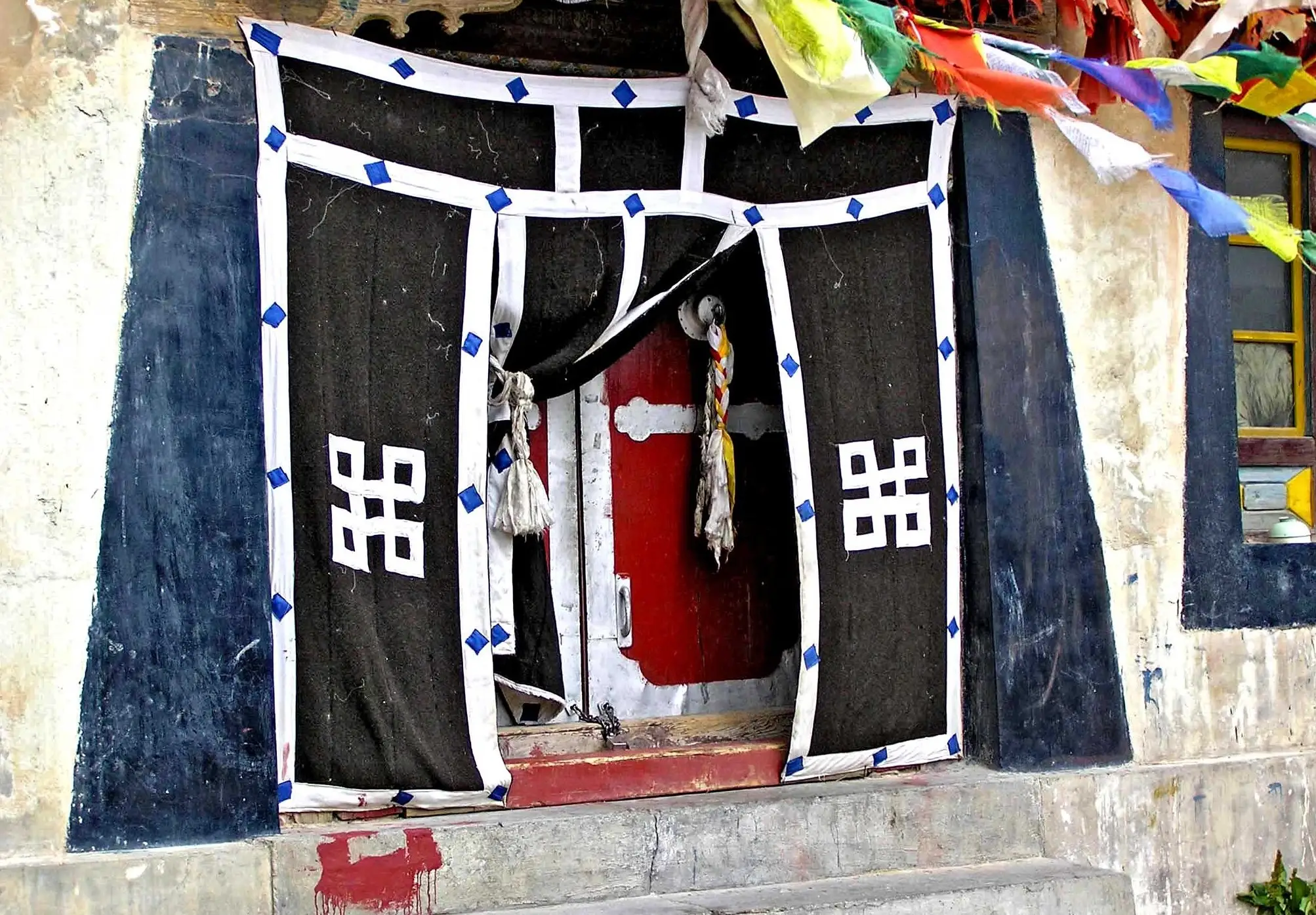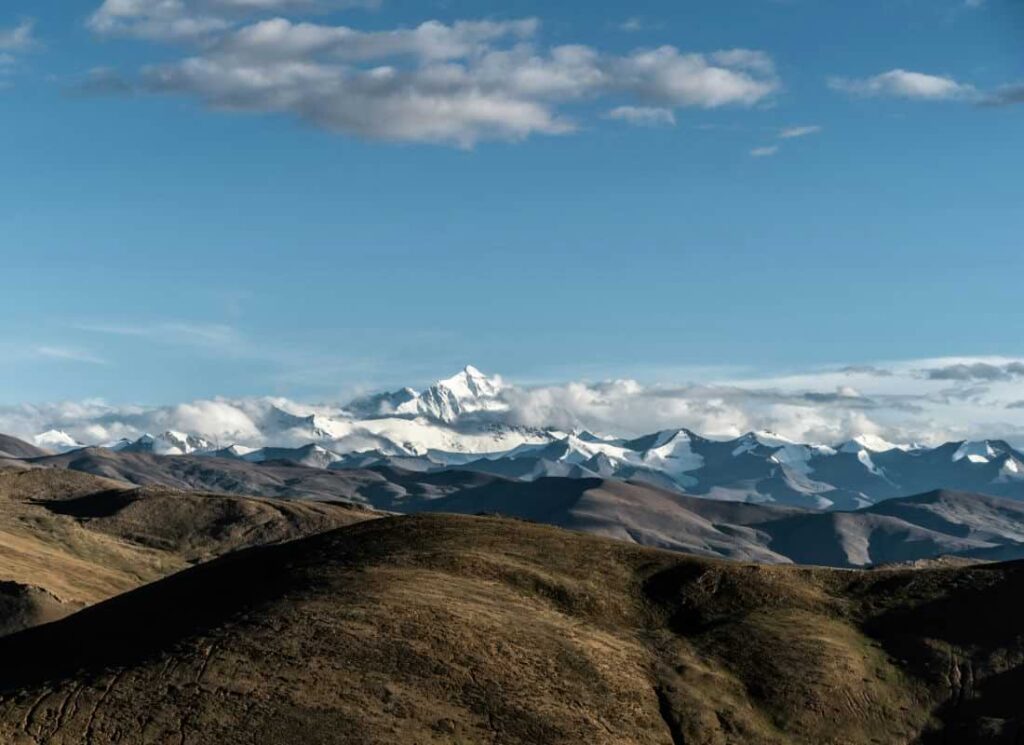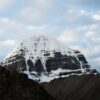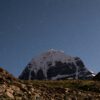Milarepa Cave in Tibet

Milarepa Cave is the Cave associated with the greatest yogi in the history of Tibet. He was born on 25 th of July in 1040 AD in Ghungtang, Tibet, which is close to the border of Nepal. Milarepa Cave is also known as Namkading Cave, and it is located 11 kilometers (7 mi) north of the town of Nyalam at Gangka village.
It is located in Nyalam County, Tibet, on the slope above the Matsang River and beneath the China–Nepal Friendship Highway. Milarepa’s Cave is reached from the gompa’s vestibule and has a view of the entrance to the Lapchi Gang’s hidden valley.
According to the biography, after years of effort, Milarepa’s solitary meditation in caves and mountain retreats led to “a deep experiential realization about the true nature of reality.” Marpa, the Tantric guru of Milarepa, instructed Milarepa to do this.
Milarepa lived in Tibet during the reintroduction of Buddhism, known as the “second dissemination” (10th–12th century). Rinchen Zangpo (958–1055), who translated sutras, tantras, and commentaries; Atiśa (982–1054), whose pupil Dromtön established the Kadam school of Tibetan Buddhism; and Marpa Lotsawa, who taught Milarepa and was considered a student of Naropa, were three important figures in this Tibetan Renaissance.
Marpa brought oral teachings and tantric manuscripts from the Bengali Siddha tradition to Tibet. Additionally, Marpa’s alleged relationship with Naropa formed the Kagyu school’s lineage, which traces back to the Buddha himself.
Two monks maintain the Cave as a shrine, watching over a glass-cased statue of Milarepa. In the Cave, there is a rock impression that is related to Milarepa’s sitting meditation position and a handprint that is claimed to have been made when Milarepa assisted his student Rechungpa (1083/4–1161 CE) in using a boulder to support the ceiling.
Images of Milarepa, Tsongkhapa, and Shri Devi—a protector whose mule is supposed to have left a footprint in the stone when she visited Milarepa in a vision—are displayed.
Story of Milarepa And Milarepa Cave
In the early 11th century, in the small village of Tibet, there was a boy named Milarepa. When he was seven years old, his father passed away, leaving Milarepa under the care of his uncle and aunt. Milarepa’s father was a wealthy landowner, but everything changed when he passed away.
Before his father died, he made a proposal that until Milarepa became an adult, his uncle and aunt would take care of his property. Following that, everything changes in Milarepa’s life, and his mother and sister begin to suffer greatly since his uncle and aunt are overly greedy. Milarepa and his mother end up as his uncle and aunt’s slaves, and they never give their belongings back.
For this reason, in order to seek revenge, the mother of Milarepa sent Milarepa to learn black magic. Upon rapidly mastering the black magic from renowned and powerful guru Nubchung Yonten Gyatso and Yungton Trogyal, he murdered about thirty-five people.
Additionally, he caused the hell storm that destroyed all of the enemy’s crops. As a result, he felt terrible about it and wanted to turn his life around. This is also the reason he is known as a murderer at a young age. After that, he met Guru Marpa Chokyi Lodror, widely known as ‘Marpa’.

Milarepa sought protection from a dharma master who could shield him from such a terrible fate after recognizing the evil he had caused and the repercussions of his transgressions. After learning of Milarepa’s karmic connections to Marpa, the Nyingmapa Lama Rongton, with whom he initially got close, sent him to study under him.
Marpa was tough with this putative disciple. He refused to teach him any dharma and derisively called him “Sorcerer,” a nickname that stuck with him for a very long time.
If Milarepa ventured into the chamber where the empowerment or lecture was to take place, Marpa would get up from his chair in a fit of rage, beat him rough, and send him out.
The most well-known instance of this kind of fury occurred when Milarepa was required to construct and rebuild a rock tower three times by herself. Even in the face of extreme challenges, he remained dedicated to his Guru, Marpha. Marpa knew his methods had finally produced the desired effect after years of brutally training Milarepa.
The core of the teachings that Milarepa had received from Naropa himself, especially those related to Chakrasamvara practices, was then imparted to him by Marpa, who sent him up to the mountains to practice severe retreat.
Milerapa then begins reciting the mantra while meditating alone in the Cave. It is thought that the Dakini then met Milarepa in the Cave and informed him that his guru had not taught him all the lessons. Then he told his guru, Marpa, about what had happened.
After realizing that Dakinis couldn’t be wrong, Marpa and Milarepa visited Marpha’s Indian guru, Naropa. Naropa then informed Marpha that he had taught every lesson but the final one because he felt unqualified and was looking for the ideal student, similar to Milarepa.
Then, with a lot of hard labour and fervent guru devotion, Milarepa attained complete self-transformation following his final lecture from Guru Naropa. He achieved full enlightenment of Buddhahood in a comparatively short time. He then spent the remainder of his life travelling and spreading Dharma via his songs.
Milarepa’s Spiritual Journey to Mount Kailash
No one has ever ascended the sacred Mount Kailash in Kalyug. The Kali Yuga is regarded as the world’s present age in Hinduism. However, a story of Milarepa, the legendary Tibetan Buddhist monk and yogi, believed to be the only person to have successfully climbed the sacred Mount Kailash. Mount Kailash is found in different Hindu religious texts such as Shiva Puran, Shri Matsaya Puran, and Rakanda Puran.
Here, it is written about Mt. Kailash’s divine power and spiritual significance. Kailash is taken as the home of the lord Shiva (Hindu God). During the Kailash Mansarovar Yatra, pilgrims do the circumambulation of this holy Mountain. Mt. Kailash is a mystery in itself. According to legend, Milarepa climbed Mt. Kailash In 1093.
Milarepa, the revered yogi, approached the sacred grounds near Mount Kailash; he met Naro Bonchung, a renowned teacher of the Bon tradition. Naro Bonchung then asked Milarepa, “Why have you come to Mount Kailash?”. Then Milarepa answered, “I am here to honour this sacred mountain. I wish to feel its divine energy and seek its blessings.”
Then Naro Bonchung said this is the site of holy Yungdrung Bon, and if Milarepa wanted to stay here, he needs to win the battle against him. Then, after a series of battles, the Naro Bonchung lost the battle. Milarepa said, “The divine does not favour one above the other. We each walk our own path to enlightenment,” he said. After that, Milarepa banishes him to the distant Mountain.
During his climb to Mount Kailash, Milerapa noticed something extraordinary about the place and realized that ordinary individuals (those who are not enlightened) should not attempt to ascend it. Since then, no one has ever climbed this sacred Mountain.
It has become a major pilgrimage site for followers of Hinduism, Buddhism, Jainism, and Bon.
Milarepa Cave In Nepal
On the Annapurna Circuit, close to Manang, at an elevation of roughly 13,450 feet, is Nepal’s Milarepa Cave, which is deeply spiritually significant. Like Tibet’s Milarepa Cave, this holy location celebrates Milarepa’s rich spiritual heritage. Because pilgrims come to consider his teachings and draw inspiration from his austere lifestyle, it is a highly regarded location for meditation and spiritual development.







